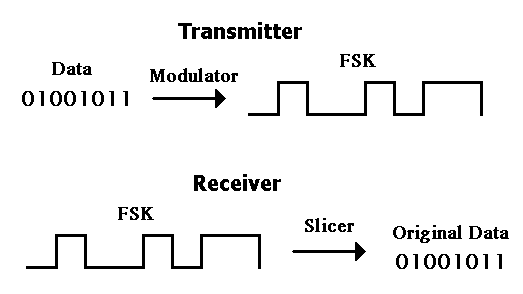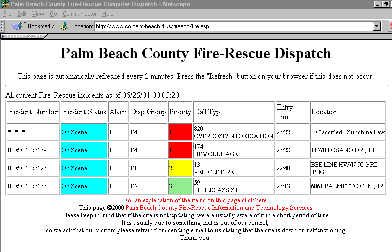More and more public safety radio systems are transitioning from analog to digital service. While these transitions mean that the voice content can no longer be heard, it is often possible to identify talkgroups and other system activity using a trunk-tracking scanner.
Hi,I live in Palm Beach County, Florida and the county has recently switched to APCO-25 digital radios. All the agencies including the city radios have been switched to digital mode. The county fire and the Sheriff have been placed on the system but in analog mode. With a BC780 will I be able to track these two in analog mode?
Thanks for your help,
Mike
The quick answer, Mike, is yes. To understand how analog and digital voice traffic fit together will take some explaining.
In a trunked radio system, the controller uses one of the assigned radio frequencies to continuously transmit data from the repeater out to the radios in the field. This is called the control channel and it carries an unending stream of messages for the mobile radios. Each message has a specific, predefined format and communicates such things as background data and system identification, channel grant and channel busy information, and various types of handshaking.
In order to follow a Motorola trunked radio system, a scanner must be able to decode and interpret the messages carried in the control channel.
 Motorola systems with analog voice channels have a control channel
that transmits data at the rate of 3,600 bits per second (bps) using
a modulation method known as two-level Frequency Shift Keying (FSK).
The repeater transmits one of two frequencies depending on the data
fed into it. Bits with a value of '0'
are sent as one frequency and bits with a value of '1' are sent as a different frequency. All the receiver has
to do is follow the two frequencies to figure out what data bits are
being sent.
Motorola systems with analog voice channels have a control channel
that transmits data at the rate of 3,600 bits per second (bps) using
a modulation method known as two-level Frequency Shift Keying (FSK).
The repeater transmits one of two frequencies depending on the data
fed into it. Bits with a value of '0'
are sent as one frequency and bits with a value of '1' are sent as a different frequency. All the receiver has
to do is follow the two frequencies to figure out what data bits are
being sent.
The simplicity of this signaling method means that the discriminator output of a scanner can be fed into a simple op-amp level comparator (the circuit is commonly called a "data slicer") and the resulting output will be the transmitted stream of bits. The popular "hamcomm" interfaces make use of this principle, and the same idea is used in most trunk-tracking scanners.
Scanners on the market today that follow Motorola systems are designed to decode two-level FSK modulation at 3600 bps and interpret the corresponding messages. As long as the system uses this scheme on the control channel, the scanner will track talkgroup activity.
Analog and Digital Voice
Radio channels that carry voice traffic can be either analog or digital. Analog traffic on a Motorola system has a sub-audible signal that transfers handshake data between the mobile radio and the repeater while a conversation is in progress.
Digital traffic is typically the output of a voice encoder-decoder (vocoder). The analog signal from the microphone is compressed and digitized by the vocoder according to a set of procedures. In the case of APCO Project 25 (P-25), these procedures are summarized as Improved Multi-Band Excitation, or IMBE.
IMBE requires a much higher signaling rate in the voice channel than what is used in the standard Motorola control channel. The vocoder converts the voice signal from the microphone into digital data at a rate of 4,400 bps. An additional 2,400 bps worth of signaling information is added, along with 2,800 bps of forward error correction to protect the bits during transmission. The combined channel rate for IMBE in Project 25 radios is 9600 bps, or nearly three times the rate of the control channel. Project 25 specifies a more efficient, but more complicated, modulation method known as C4FM that is very different from the two-level FSK used on the control channel.
P-25 radios are supposed to be backward compatible, meaning they should be able to operate in analog mode with older analog radios and in digital mode with other P-25 radios. If an agency wants to mix old analog radios with P-25 radios, the system must use a control channel that both types of radios can understand. That means a trunked radio system with analog radios must use a 3600 bps control channel.
Since the control channel is separate from the voice channel, nearly any Motorola system can make use of IMBE radios as long as the 3600 bps control channel is maintained.
PROJECT 25 Trunking
Project 25 is a set of standards, some mandatory and some optional. One of the optional standards is a specification for digital trunking that is completely different from the method used by Motorola in their analog systems. It uses a 9600 bps control channel and shares the same C4FM modulation method as the digital voice channels. A system that uses Project 25 digital trunking will not interoperate with older analog radios, since the analog radios are unable to decode the 9600 bps C4FM control channel. Fortunately for scanner listeners, there are very few active Project 25 digital trunking systems.
|
Analog Only |
Analog and P-25 Digital |
P-25 Digital Only |
|
|
3600 bps control channel |
YES |
YES |
MAYBE |
|
9600 bps control channel |
NO |
NO |
MAYBE |
|
Analog voice |
YES |
SOME |
NO |
|
IMBE voice |
NO |
SOME |
YES |
ASTRO VSELP
To add a little more confusion, Motorola has sold digital systems that use a different type of vocoder, known as Vector Sum Excited Linear Prediction (VSELP). Cleveland, Ohio, and Memphis, Tennessee, are two cities that use VSELP. These systems also use the Motorola 3600 bps control channel but are not interoperable with the digital voice features of APCO-25 radios.
Palm Beach County, Florida
Now, back to Palm Beach County. The previous VHF system used by the Palm Beach County Sheriff and the conventional (non-trunked) 800 MHz in Boca Raton have been replaced by a ten site, 26 channel Motorola Smartzone system with Project 25 capability. This will also allow adjacent communities to talk with each other, as well as with the nearby counties of Broward, Martin, and Miami-Dade.
Boca Raton, Boynton Beach, and Delray Beach made the switch earlier this year. So far Police and Fire department transmissions are IMBE digital, while Public Works are analog.
Frequencies are 856.3125, 856.3375, 857.3125, 857.3375, 858.3125, 858.3375, 859.3125, 859.3375, 860.3125, 860.3375, 866.100, 866.125, 866.325, 866.500, 866.600, 866.625, 866.725, 866.750, 866.250, 866.850, 867.100, 867.325, 867.350, 867.375, 867.400, 867.575, 867.800, 868.225, 868.375, 868.400, 868.650, 868.700, and 868.725 MHz.
If you have web access, Palm Beach County has a live Computer Aided Dispatch (CAD) web page that is updated every two minutes. The address is http://www.co.palm-beach.fl.us/fireapp/fire.asp.

(Click for a larger version)
Wayne County, Michigan
From: "DLess"
Subject: help
Date: Thu, 7 Jun 2001 21:56:40 -0400I live in the southern Downriver area of Wayne County, Michigan. (near Detroit). I monitor using an Icom IC R7100. Until Tuesday I was monitoring my local police departments (Grosse Ile, Trenton, Woodhaven, Flat Rock and Rock Wood) at 155.6400 Mhz. They have disappeared!
I asked a police officer about that and he responded that they have gone to an 800MHz system with 38 channels. When I checked the FCC data base at your website I can find no 800MHz frequencies listed for Grosse Ile, Trenton, Flat Rock, Michigan. Any suggestions as to what I can do?
Any help you can give me would be appreciated.
A Michigan Scanner
The old Wayne County Downriver Mutual Aid system, callsign WPIU702, has transitioned to a digital system for the municipalities of Allen Park, Brownstown Township, Ecorse, Flat Rock, Gibraltar, Grosse Ile Township, Lincoln Park, Melvindale, River Rouge, Riverview, Romulus, Southgate, Taylor, Trenton, Woodhaven and Wyandotte.
Assigned frequencies are 866.5750, 866.600, 866.625, 866.825, 867.050, 867.125, 867.200, 867.2625, 867.575, 867.775, 867.800, 867.8250, 868.075, 868.100, 868.1250, 868.3375, 868.4875, 868.650, 868.750 and 868.8375 MHz.
Wayne County is also home to an interesting consolidation of police and fire dispatch centers. The cities of Dearborn Heights, Garden City, Inkster, Westland and Wayne have gone in together to share the cost of their new 800 MHz radio system. Each city will pay for their own radios, but will split the $2 million cost for repeaters and other common equipment. A 300-foot radio tower behind the Westland police station will be the primary repeater site, although Dearborn Heights, Garden City and Wayne will continue to dispatch from their own stations.
The assigned frequencies for the system are 866.550, 866.6125, 866.775, 867.250, 867.550, 867.750, 868.050, 868.1375, 868.1875, 868.5625, 868.775 and 868.800 MHz, but it appears that voice transmissions are digital.
State of Michigan
At the state level, the Michigan Public Safety Communications System (MPSCS) has completed the third phase of their $187 million project to replace the old low band VHF radio network with an 800 MHz P-25 digital Motorola system.
Phases one and two provided service to southeast, southwest, and west-central Michigan, including the cities of Detroit, Jackson, Lansing, and Grand Rapids. Phase three completed coverage for the entire lower Peninsula in March, although data services will not be available for another three years. Phase four will cover the Upper Peninsula and finish out the project.
When complete, the state will have 181 towers, each with at least five repeaters and some with as many as twelve. Seven dispatch centers will operate the system from locations in Bridgeport, East Lansing, Gaylord, Negaunee, Northville, Paw Paw and Rockford.
More than 50 public safety agencies and nearly 8,000 radios are currently using the system. Besides local and state agencies, Federal users include the Federal Bureau of Investigation, Secret Service, and Customs Service.
Scanners in Michigan
As silly as it sounds, a permit is required to have a scanner in a vehicle while in Michigan. Under Michigan law 750.508, having a scanner capable of receiving police frequencies is a misdemeanor punishable by a fine of as much as $500.00 and up to a year in jail. Unless the car is owned or used by a "peace officer" or a licensed amateur radio operator, you must have a state-issued permit to legally possess such a scanner. Here is the actual text of the law:
Any person who shall equip a vehicle with a radio receiving set that will receive signals sent on frequencies assigned by the Federal Communications Commission of the United States of America for police purposes, or use the same in this state unless such vehicle is used or owned by a peace officer or a bona fide amateur radio operator holding a technician class, general, advanced, or extra class amateur license issued by the federal communications commission, without first securing a permit to do so from the director of the department of state police upon application as he or she may prescribe, shall be guilty of a misdemeanor, punishable by imprisonment in the county jail for not more than 1 year, or by a fine of not more than $500.00, or by both fine and imprisonment in the discretion of the court.
An application may be requested by calling (517) 336-6240 or downloaded from the web at www.mpscs.com/com-022.pdf.
That's all for this month. I welcome your questions and comments via electronic mail at dan@signalharbor.com, and more information is available at www.signalharbor.com. Until next month, happy monitoring!